Artists P - T
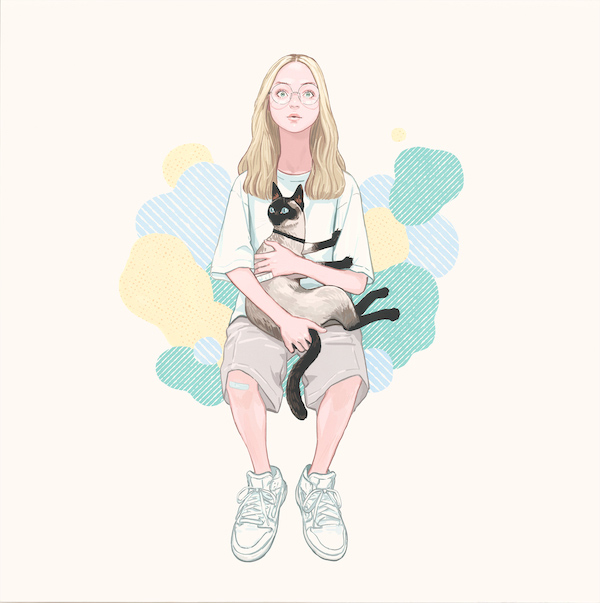
Yusuke Saitoh
Chack and the Girl
Giclée print on canvas, 36 x 36 inches, 2019
Yusuke Saitoh (b. 1978) is an illustrator from Kanagawa. Trained at the Vantan Design Institute in Tokyo, he produces realistic digital paintings and animations, many of which have been featured in the music, film, fashion, advertising, and publishing industries, both internationally and in Japan. In addition to drawing characters for these creative fields, he also makes work that expresses the struggles that he has faced personally as an artist. His process allows him to explore the various possibilities of art and discover his own potential.
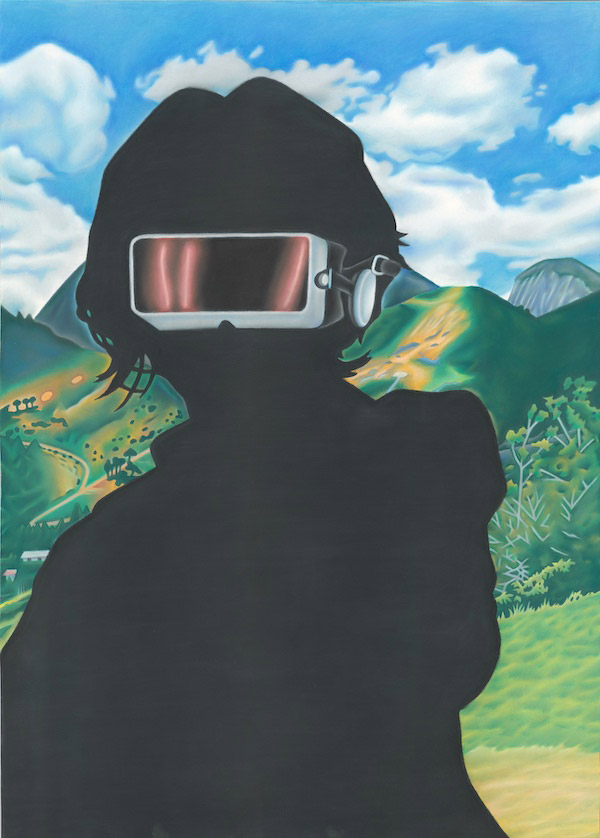
Norishige Sasabe
Unknown Goggles
Pastels and colored pencils on paper, 40 1/2 x 28 1/2 inches, 2021
Norishige Sasabe (b. 1973) is best known for his nostalgic images of traditional culture and customs. In 2020, however, he began creating imagery that addresses the present and near future and issues such as climate change, artificial intelligence, cloning, biotechnology, and virtual space. His new works, which feature color gradations (made with pastels) and rubbed-out areas, are darker in palette and deeper in tone, illustrating contemporary scenes and events through his own personal filter. Here, a silhouetted figure stands in beautiful natural landscape but is instead consumed by what he sees in his VR goggles.
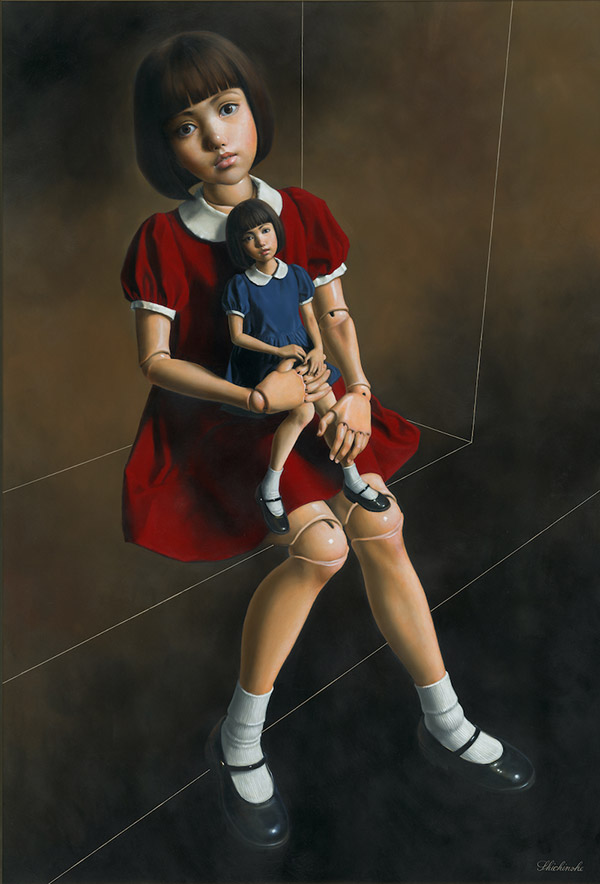
Masaru Shichinohe
Doll Play
Oil on canvas, 46 x 32 inches, 2021
Masaru Shichinohe (b. 1959) majored in architecture at Musashino Art University in Tokyo, but soon after, he began a career as a professional painter. Largely self-taught as an artist, he has dedicated himself to capturing a nostalgia for the ephemeral joys of childhood, portraying young boys and girls in dark, often surreal settings. His works are laden with symbolism and silence and provoke many questions. Here, the image appears to be of a young girl sitting with a doll on her lap, on closer inspection, however, the scene unravels into something more dreamlike and mysterious.
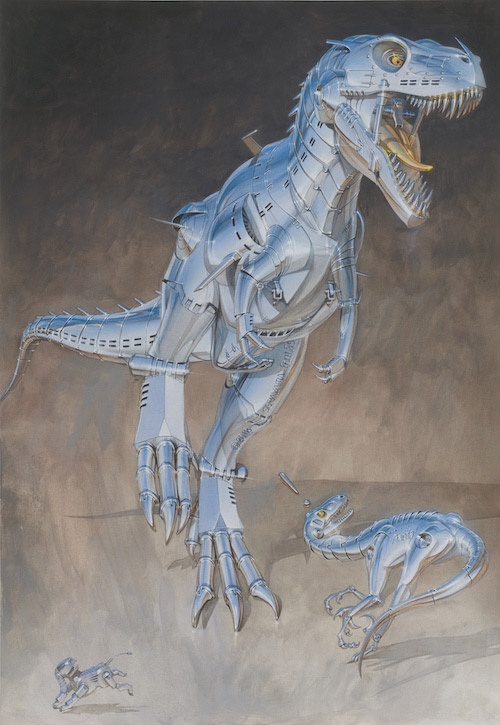
Hajime Sorayama
TREX (A)
Canon 12-color hybrid digital print on paper, 59 x 42 1/2 inches, 2020
Hajime Sorayama (b. 1947) graduated from Central Art School (Chubi) in Tokyo and worked in advertising before becoming a freelance illustrator in 1971. In 1978, Sorayama drew his first robot, and in the 1980s he gained much attention for his series of “Sexy Robots,” which he modeled after pin-up art. His precise, highly detailed, superreal images explore ideas of closeness and embody the human impulse to pursue beauty. At the same time, his robots encompass various important themes of contemporary society, such as racial boundaries, eternal life, and the fusion of technology and beauty. His images of robot dinosaurs similarly play with concepts of technology and chronology, history and sci-fi.
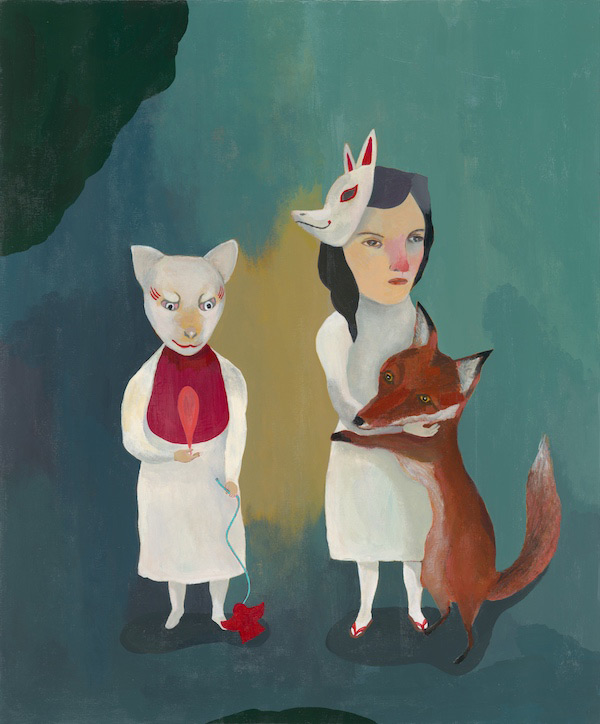
Mica Suga
Pretend Play
Acrylic on canvas, 28 1/2 x 24 inches, 2021
Originally from Oita prefecture, Mica Suga trained in fashion illustration and copperplate etching at a woodblock printing studio. As an illustrator, she creates paintings and paper prints, occasionally combining the techniques in collages made with scraps of fine paper that she collects and reuses. Many of her works feature women that are unsmiling and appear uneasy, as if viewing the world with distrust or emotional detachment. Her characters and scenes are typically quirky or absurd, as in this image of characters pretending to be foxes while embracing real foxes. Suga has shown in several group and solo exhibitions in Japan.
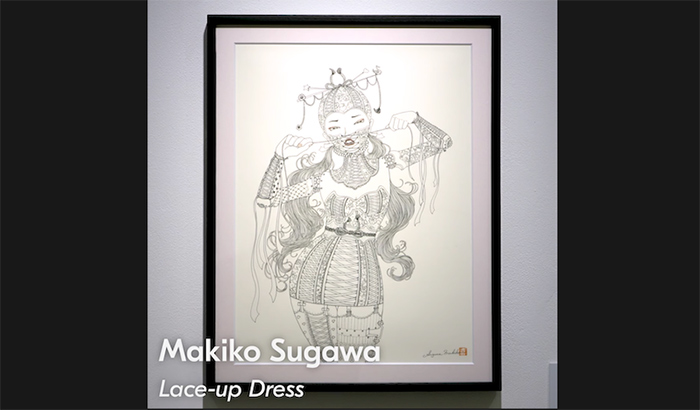
Makiko Sugawa
Lace-up Dress by Makiko Sugawa
Pen, pencil and acrylic pigment on paper, 20 x 15 1/2 inches, 2021
Originally from Wakayama prefecture, Makiko Sugawa (b. 1974) graduated from Kyoto College of Art and went on to work as a designer. She developed a very refined style of drawing with slender, delicate lines and meticulous detailing. She specializes in female figures and dolls with limbs that appear to be attached with decorative joints and hinges. The women are strong and sensual, wearing lace and lingerie and exuding confidence and independence. Sugawa lost her leg to cancer and champions amputees in her work, sending a message that there is beauty and strength in physical imperfection.
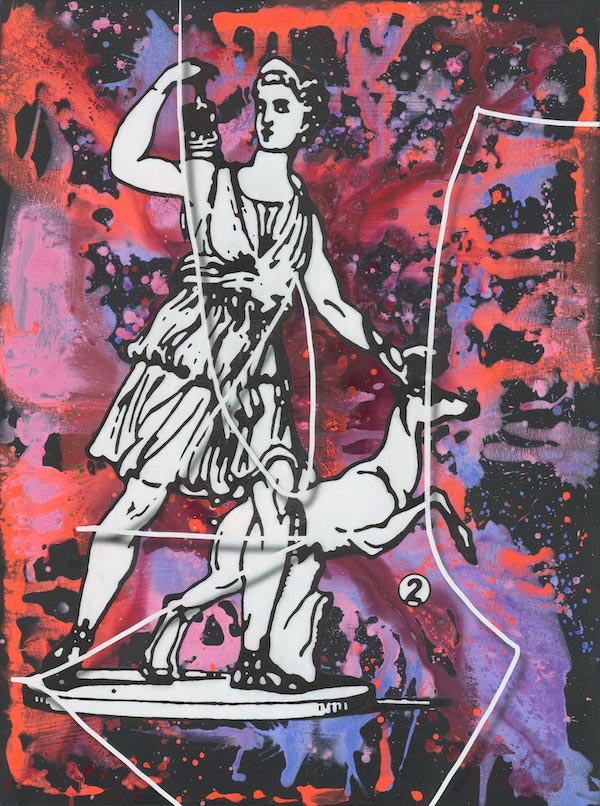
Hiro Sugiyama
Untitled
Acrylic on canvas, 51 1/2 x 38 inches, 2020
One of the organizers and curators of the Tokyo WAVE exhibition and this JAPAN HOUSE touring exhibition, Hiro Sugiyama (b. 1962) is a Tokyo-based artist whose prolific output has included figurative and abstract painting, superrealistic portraiture, prints, photography, and collage. In much of his work, he explores points of intersection between dualities—life and death, reality and unreality, abstract and concrete, digital and analog—expressing the narrow space where opposites meet. In this work, a line-drawn classical image of the Greek goddess of the hunt, Diana, is set against a boldly painted abstract ground. The realistically rendered white string that zigzags over the canvas seems to further bind together these otherwise distant forms of artistic expression.
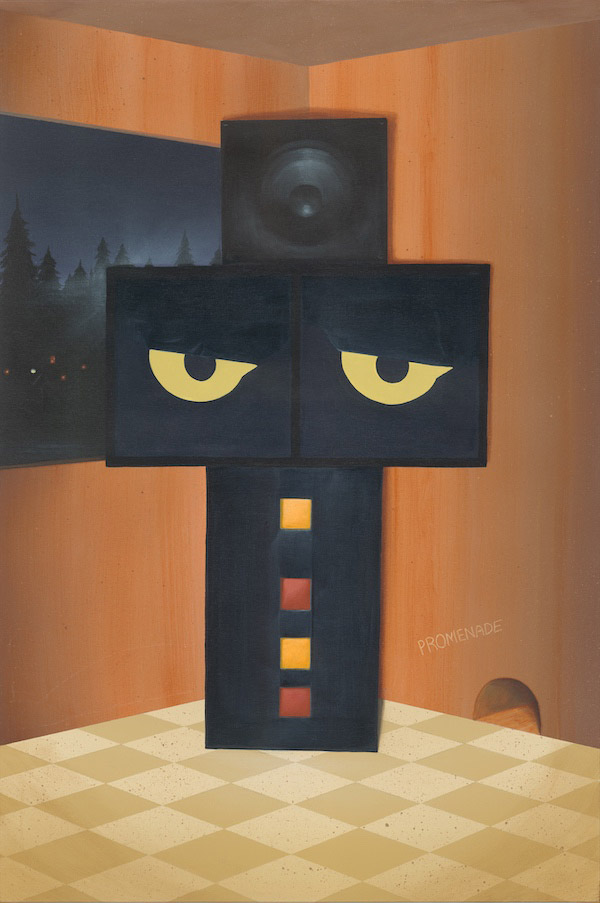
Makito Takagi
Snap-49
Acrylic on canvas and panel, 36 x 24 inches, 2021
Makito Takagi (b. 1986) is a pop-art illustrator who designs quirky creatures seemingly constructed from random objects, or human or animal parts. Many of his monster-like cartoon characters pose like superheroes in front of photorealistic buildings, walls, verandas, and other settings, resulting in ambiguous images that straddle the line between reality and the virtual realm. Through his skillful use of light and shading, Takagi creates works that appear like snapshots of these imagined creatures in the real world, evoking vintage photographs of Nessie and Bigfoot. In this painting, he portrays a curious character as if captured in the flash of a nighttime photograph.
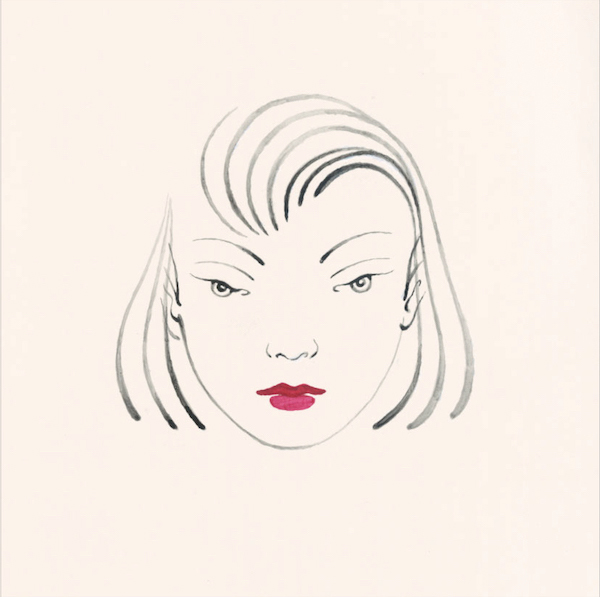
Kintaro Takahashi
April Girl
Acrylic on canvas, 39 1/2 x 39 1/2 inches, 2021
Kintaro Takahashi (b. 1955) is from Matsumoto City in Nagano prefecture. While studying graphic design at Tama Art University in Tokyo, he became interested in illustration and now specializes in illustrative work with a delicate touch. In this painting, he portrays the face of a girl in April, using minimal brushstrokes and pigments—simply adding a deep red to emphasize and energize her lips, perhaps to suggest young love. Takahashi prefers to draw from his memory of his subjects, rather than directly from reality. He is an organizer of the WAVE exhibition in Tokyo and a curator of this JAPAN HOUSE touring exhibition.
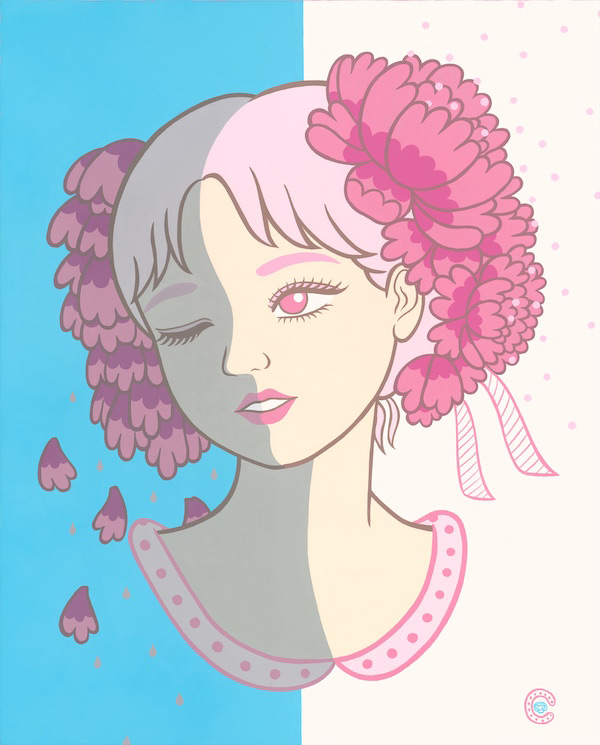
Chika Takei
On and Off
Acrylic and gouache on canvas, 25 1/2 x 21 inches, 2021
Originally from Utsunomiya City in Tochigi prefecture, Chika Takei (b. 1982) began her career in illustration shortly after graduating from Illustration Aoyama Juku. Her highly stylized images of mostly female characters are colorful and moody, and over the years, they have been inspired by pop stars such as Britney Spears. Precisely detailed with extremely fine-point brushes, her figures are often playful and emotionally expressive. Her work has appeared in books, magazines, posters, online ads, official celebrity merchandise, and studio design for the Japanese television network TBS, and it has also been shown widely in art galleries.
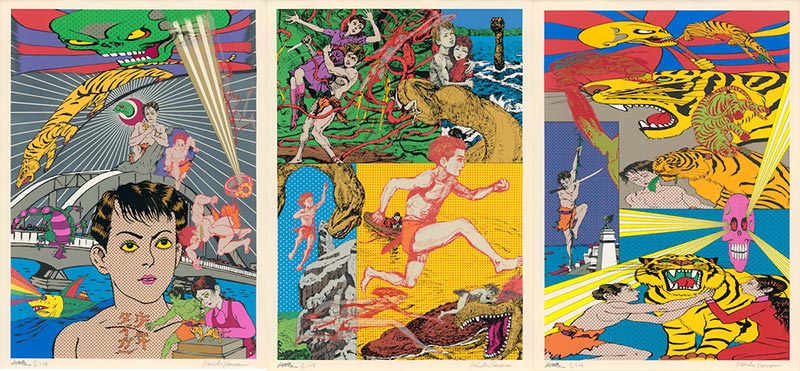
Keiichi Tanaami
left: Shonen Tiger 01, center: Shonen Oja,
right: Shonen Tiger 02
Silkscreen print on paper, 40 1/2 x 29 inches each, 2008
Keiichi Tanaami (b. 1936) is one of Japan’s leading pop artists. Since the 1960s, he has worked as a graphic designer, illustrator, and video artist, showing his artwork in numerous exhibitions in Japan and internationally.
He is best known for his densely packed and colorful images containing scenes from his childhood during World War II, details from his dreams, and comical motifs from pop culture. While in New York in the late 1960s, Tanaami was inspired by Andy Warhol to challenge the role of the artist and art in the art world, commerce, and daily life. He has used his work to protest war and to decorate album covers and has trained many young artists at Kyoto University of Art and Design. These three prints were developed using original postwar-period picture book illustrations from Soji Yamakawa (1908–1992), author of the Shonen Tiger and Shonen Oja series. The posthumous collaboration between Yamakawa and Tanaami was part of a retrospective of Yamakawa’s work held in 2008, to commemorate the one-hundredth anniversary of his birth.
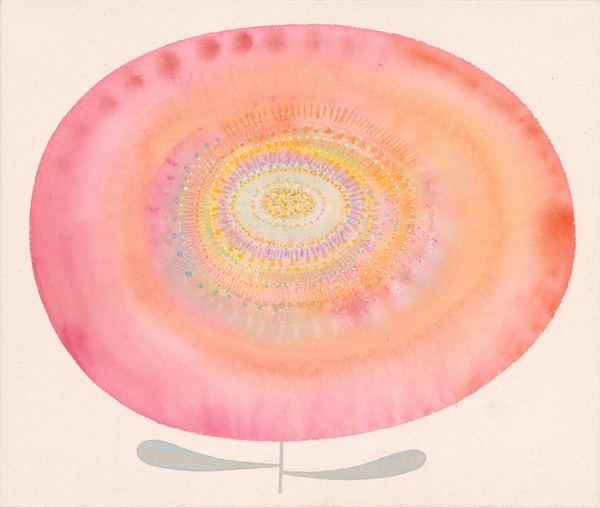
Hiroki Taniguchi
The Here, There, and Everywhere Flower
Mixed media on canvas, 19 x 22 inches, 2020
From Kawasaki City in Kanagawa, Hiroki Taniguchi (1957-2021) studied at Tokyo University of the Arts. He worked as an illustrator creating simple, charming, and often whimsical images that have graced numerous book covers, posters, and stationery items, and his work has been featured in many solo and group exhibitions. Taniguchi considered Japan and his own Japanese-ness fundamental to his artistic expression, and motifs from Japanese daily life, such as rice bowls and chopsticks, vegetables, flowers, and folk gods, abound in his work.
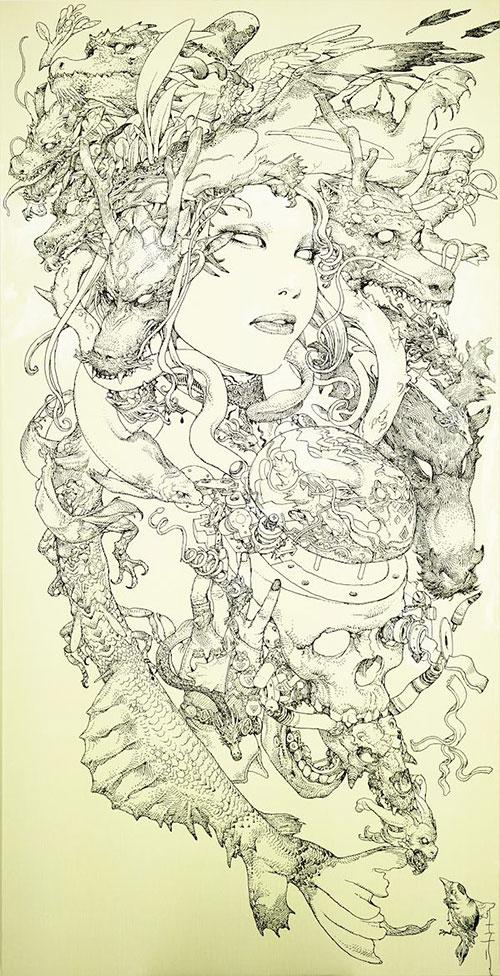
Katsuya Terada
Untitled
Digital print on canvas (Original: Marker on canvas, 2017), 46 x 23 1/2 inches, 2021
Katsuya Terada (b. 1963) is an illustrator and manga artist from Okayama. He calls himself a rakugaki artist (meaning a “scribbler” or “doodler”), as he likes to draw a little everywhere and all the time. As a manga and anime artist, he has designed characters for Japanese animated films and series, created artwork for several video games, and worked on American comics such as Iron Man and Hellboy. As an illustrator and artist, he pushes—with pens and digital tools alike—the boundaries of manga and art through the exploration of the line as it expands outward, building into elaborate clusters of motifs drawn from dreams, fantasies, and the natural realm.
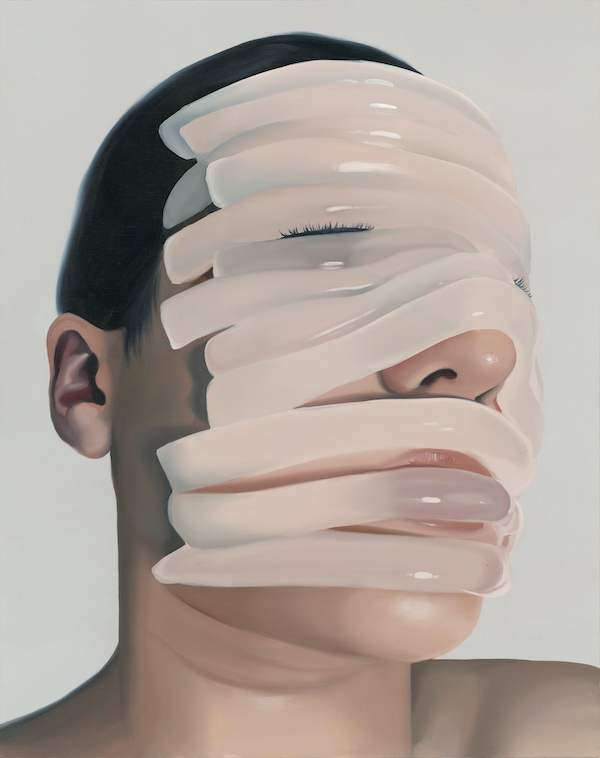
Kotao Tomozawa
slimeLXXV
Oil on canvas, 36 x 28 1/2 inches, 2021
Kotao Tomozawa (b. 1999) was born in Bordeaux, France. She came to Japan from Paris in 2004 and is currently studying at Tokyo University of the Arts, majoring in oil painting, while also exhibiting her work in galleries. Her portraits typically feature faces covered with slime-like substances. The texture, translucency, and softness of the materials are meticulously depicted, leaving the viewer to question the reality of what they are looking at.
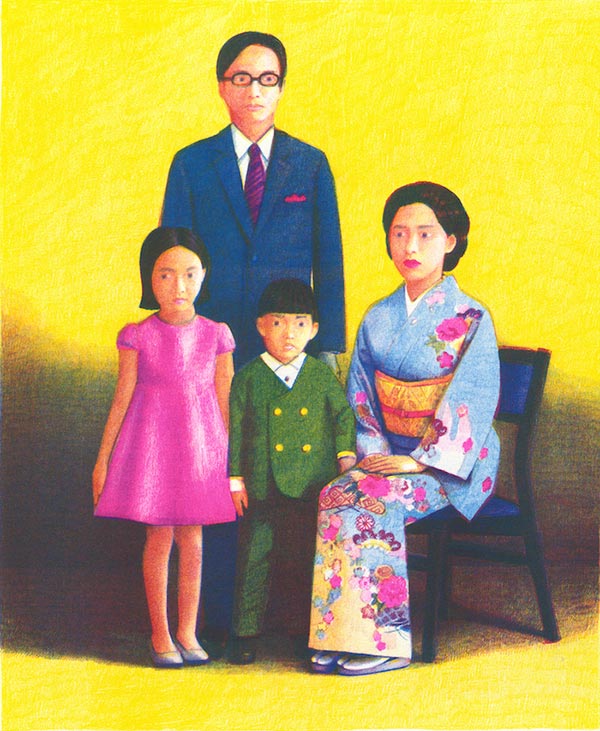
Mayumi Tsuzuki
Family Portrait
Risograph on paper, 13 1/2 x 10 1/2 inches, 2021
In this print, Mayumi Tsuzuki (b. 1966) portrays a Japanese family posing for a standard portrait, with the wife in a floral kimono and the husband and children in Western clothes. Although the family is depicted with vivid colors, the mood of the image is somber given the subjects’ uneasy, distant facial expressions and the heavy shadow that surrounds them. Tsuzuki, who studied art at Musashino Art University in Tokyo, often addresses such ambiguity in her work. Typically, her pointillist-inspired images of daily life are at once bright and colorful and dark and unsettling, reflecting the complexity of our emotional lives.
(Note: Risograph is a Japanese brand of digital duplicators that are designed mainly for high-volume photocopying and printing.)
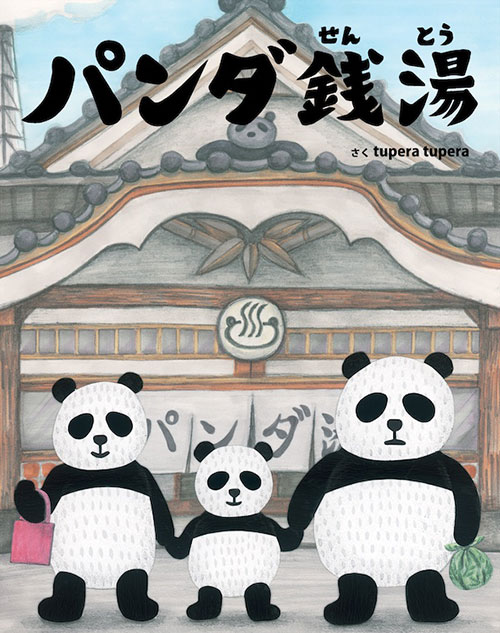
tupera tupera
Panda Bathhouse
Digital print on canvas (Original: Pencil and pen on paper, 2013), 30 x 23 1/2 inches, 2013
The artistic duo tupera tupera have created some of Japan’s most popular children’s books, including Shirokuma no pantsu (Polar Bear’s Underwear), which won the 2014 Prix du Livre Jeunesse Marseille. The Tokyo-based husband-and-wife design team, Tatsuya Kameyama (b. 1976) and Atsuko Nakagawa (b. 1978), trained in oil painting at Musashino Art University and textile dyeing at Tama Art University, respectively. Their colorful, whimsical illustrations are born out of their playful approach to their work. The painting here is the cover image for the children’s book Panda Sentō (Panda Bathhouse), which follows a panda family as they visit a traditional Japanese bathhouse.
Main Exhibition Page

